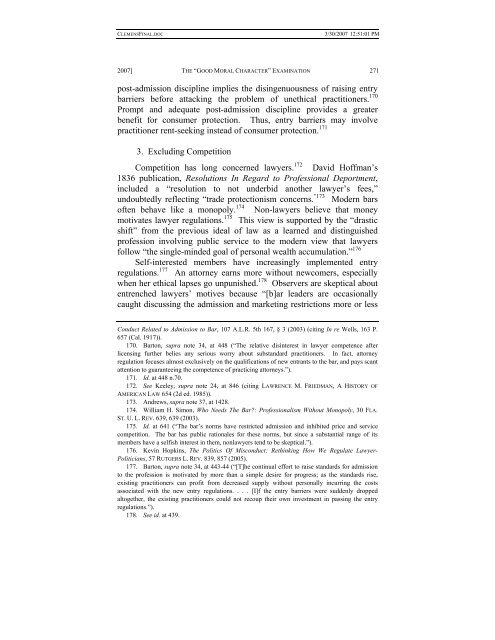Facing the Klieg Lights: Understanding the "Good Moral Character"
Facing the Klieg Lights: Understanding the "Good Moral Character"
Facing the Klieg Lights: Understanding the "Good Moral Character"
Create successful ePaper yourself
Turn your PDF publications into a flip-book with our unique Google optimized e-Paper software.
CLEMENSFINAL.DOC<br />
3/30/2007 12:51:01 PM<br />
2007] THE “GOOD MORAL CHARACTER” EXAMINATION 271<br />
post-admission discipline implies <strong>the</strong> disingenuousness of raising entry<br />
barriers before attacking <strong>the</strong> problem of unethical practitioners. 170<br />
Prompt and adequate post-admission discipline provides a greater<br />
benefit for consumer protection. Thus, entry barriers may involve<br />
practitioner rent-seeking instead of consumer protection. 171<br />
3. Excluding Competition<br />
Competition has long concerned lawyers. 172 David Hoffman’s<br />
1836 publication, Resolutions In Regard to Professional Deportment,<br />
included a “resolution to not underbid ano<strong>the</strong>r lawyer’s fees,”<br />
undoubtedly reflecting “trade protectionism concerns. ”173 Modern bars<br />
often behave like a monopoly. 174 Non-lawyers believe that money<br />
motivates lawyer regulations. 175 This view is supported by <strong>the</strong> “drastic<br />
shift” from <strong>the</strong> previous ideal of law as a learned and distinguished<br />
profession involving public service to <strong>the</strong> modern view that lawyers<br />
follow “<strong>the</strong> single-minded goal of personal wealth accumulation.” 176<br />
Self-interested members have increasingly implemented entry<br />
regulations. 177 An attorney earns more without newcomers, especially<br />
when her ethical lapses go unpunished. 178 Observers are skeptical about<br />
entrenched lawyers’ motives because “[b]ar leaders are occasionally<br />
caught discussing <strong>the</strong> admission and marketing restrictions more or less<br />
Conduct Related to Admission to Bar, 107 A.L.R. 5th 167, § 3 (2003) (citing In re Wells, 163 P.<br />
657 (Cal. 1917)).<br />
170. Barton, supra note 34, at 448 (“The relative disinterest in lawyer competence after<br />
licensing fur<strong>the</strong>r belies any serious worry about substandard practitioners. In fact, attorney<br />
regulation focuses almost exclusively on <strong>the</strong> qualifications of new entrants to <strong>the</strong> bar, and pays scant<br />
attention to guaranteeing <strong>the</strong> competence of practicing attorneys.”).<br />
171. Id. at 448 n.70.<br />
172. See Keeley, supra note 24, at 846 (citing LAWRENCE M. FRIEDMAN, A HISTORY OF<br />
AMERICAN LAW 654 (2d ed. 1985)).<br />
173. Andrews, supra note 37, at 1428.<br />
174. William H. Simon, Who Needs The Bar?: Professionalism Without Monopoly, 30 FLA.<br />
ST. U. L. REV. 639, 639 (2003).<br />
175. Id. at 641 (“The bar’s norms have restricted admission and inhibited price and service<br />
competition. The bar has public rationales for <strong>the</strong>se norms, but since a substantial range of its<br />
members have a selfish interest in <strong>the</strong>m, nonlawyers tend to be skeptical.”).<br />
176. Kevin Hopkins, The Politics Of Misconduct: Rethinking How We Regulate Lawyer-<br />
Politicians, 57 RUTGERS L. REV. 839, 857 (2005).<br />
177. Barton, supra note 34, at 443-44 (“[T]he continual effort to raise standards for admission<br />
to <strong>the</strong> profession is motivated by more than a simple desire for progress; as <strong>the</strong> standards rise,<br />
existing practitioners can profit from decreased supply without personally incurring <strong>the</strong> costs<br />
associated with <strong>the</strong> new entry regulations. . . . [I]f <strong>the</strong> entry barriers were suddenly dropped<br />
altoge<strong>the</strong>r, <strong>the</strong> existing practitioners could not recoup <strong>the</strong>ir own investment in passing <strong>the</strong> entry<br />
regulations.”).<br />
178. See id. at 439.
















